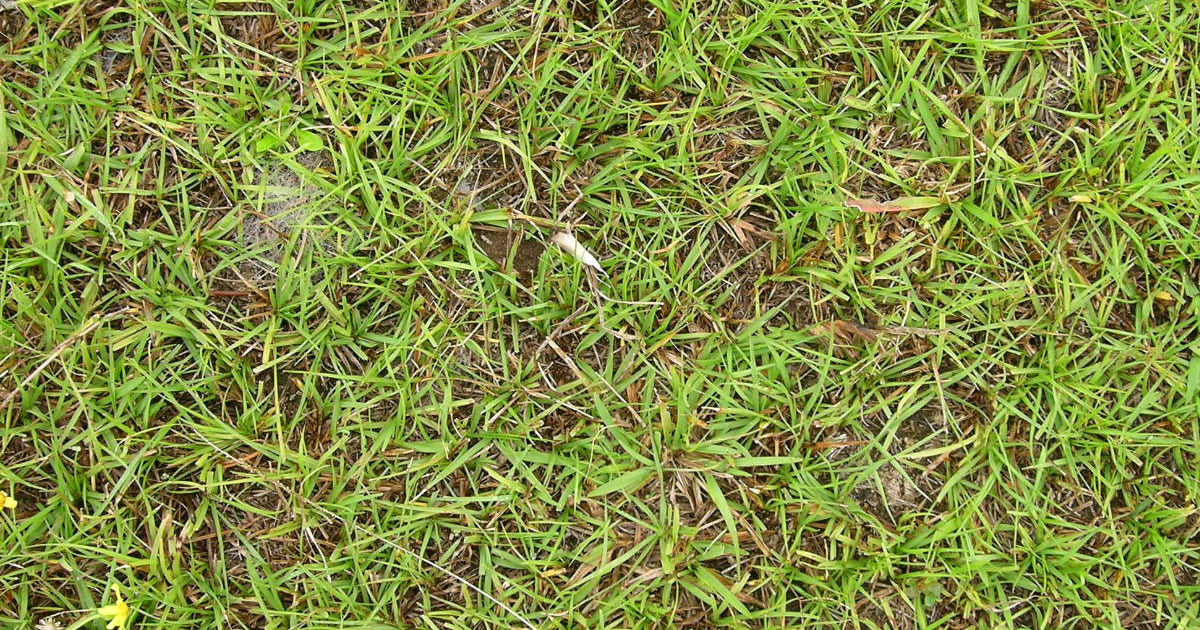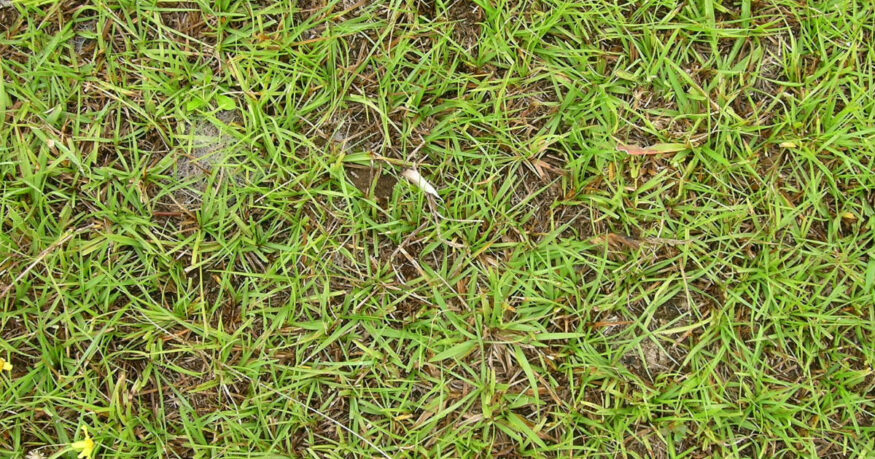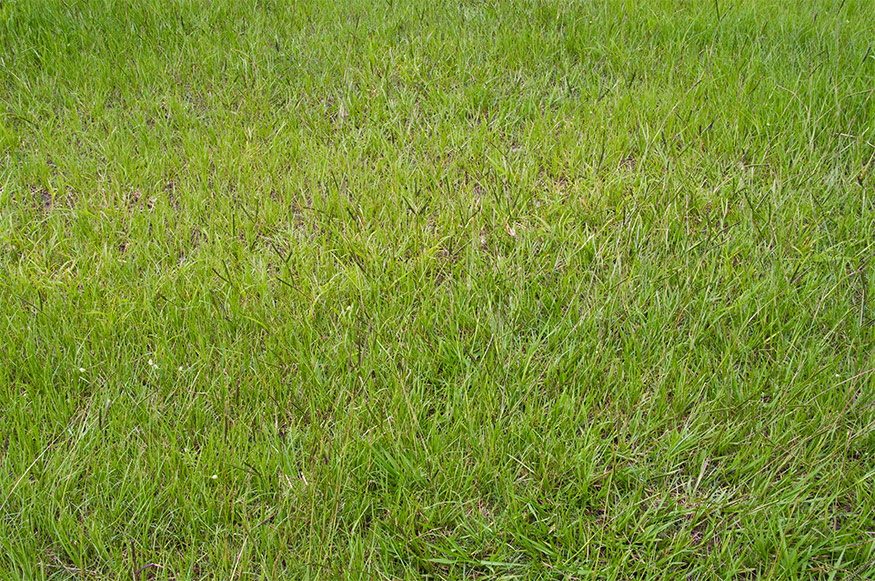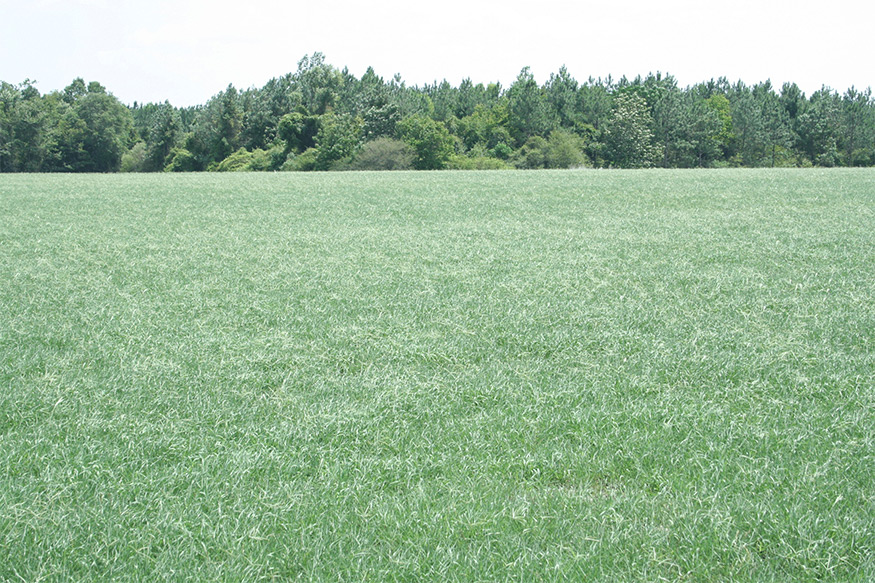Bahiagrass is a low-maintenance lawn solution for southern climates. It grows better in shade, poorly drained soil, and drought-prone areas than other warm-season grasses. But its slow growth and inability to form thick sod limit its use.
In this guide, we’ll look at important bahiagrass characteristics to help you determine if it’s right for your yard. We’ll also tell you everything you need to know to care for this warm-season grass using our helpful lawn care calendar.
Bahiagrass Overview
| Also Known As | Bahia Grass; Paspalum notatum Flugge |
| Type of Grass | Warm season perennial |
| Optimal Zones | Deep southeast |
| Root Structure | Deep |
| Winter hardiness | Poor to Fair |
| Heat tolerance | Excellent |
| Shade tolerance | Fair |
| Water Requirements | Low to Moderate |
| Drought Tolerance | Good |
| Self Repair Capacity | Low |
| Overall Maintenance Requirements | Low |
History
Bahiagrass is native to Brazil. It was first introduced to the United States in 1914. Because it grows well in sandy, dry soil, it was prized as a low-maintenance pasture grass for most of the 20th century.
Today, bahiagrass is still used predominantly as a forage grass for livestock. It begins growing sooner in the spring and continues to grow later into the fall compared to most warm-season grasses. It also tolerates overgrazing better than other options.
Bahiagrass wasn’t commonly used as a turfgrass until researchers began developing cultivators with more desirable growth habits. Of the three most common cultivators, only Argentine is widely used around homes. But even this grass is better suited to large properties than small yards.
The slow growth habits and the fact that bahia does not form dense sod continue to limit its value as a turfgrass. But it does require less water and less fertilizer than most warm-season grasses and is more resilient to drought, disease, and pests. For these reasons, it is still the best option for some homeowners.
Bahia grass Characteristics
Bahiagrass can survive less than desirable conditions, but it takes time to establish and is prone to weed problems.
To help you decide if bahia is right for your yard, let’s take a closer look at the characteristics of this species.
Type of Grass
Bahiagrass is a perennial warm-season grass. “Perennial” meaning it comes back every year. And “warm season” meaning it does most of its growing when temperatures are hot.
It turns brown and goes dormant in the winter as well as during periods of drought.
Optimal Zones
The use of bahiagrass in the US is restricted to the Deep South and Florida. Most cultivators have very limited cold tolerance and grow best in slightly acidic, sandy soil.
Root Structure
The roots of bahiagrass extend quite deep. It spreads via stolon activity and grows relatively slowly, making it difficult to establish dense turf.
Winter Hardiness
Argentine, the best cultivator for lawns, is less cold tolerant than many pasture bahiagrasses. It grows best in areas that do not experience frequent freezes over the winter.
Bahiagrass will go dormant when nighttime temperatures drop below 50 degrees. Compared to other warm-season grasses, most cultivators green up earlier in the spring.
Heat Tolerance
Bahiagrass is very heat tolerant and grows the most during the warm summer months.
Shade Tolerance
Bahiagrass is more shade tolerant than bermudagrass. But, like most warm-season grass species, it grows best in full sun.
Water Requirements & Drought Tolerance
Bahiagrass requires about half as much water as other warm-season grasses. It can also survive without water for far longer. When water is severely restricted, it will turn brown and go dormant.
Even after extended periods of drought, it tends to green up quickly once irrigation is restored.
Self Repair Capacity
High to medium-traffic yards are not a great place for bahiagrass. This species tends to thin under pressure and takes a long time to grow back when worn to the dirt.
Bahiagrass Lawn Care Calendar
Bahiagrass is not a high-maintenance grass, but it does have some unique care needs that homeowners should know about.
New lawns are typically established using seed or sod. Due to the thin growth nature, sod often falls apart, leaving a patchy look that will take time to grow in. Spreading seed in late spring at a rate of 5 pounds per 1,000 square feet is the preferred method of establishment in most cases.
Brand-new lawns take time to establish. Fertilizer should not be applied until at least 60 days after planting/sprouting. And the lawn should not be mowed until the grass is well anchored by established roots.
After about 2 months, you can begin following our bahiagrass lawn maintenance plan, below.
Spring Care
Bahiagrass will begin to green up and start growing in early to mid-spring. In southern Florida, it may never go dormant.
Mowing
Home lawns should be maintained at 3 to 4 inches in height. Slow growth means you will only need to mow every 7 to 14 days, on average. But it’s important to mow often enough to avoid removing more than ⅓ of the grass blade at a time.
Cutting the grass to higher lengths will promote deeper root growth and is recommended for areas with dry summers. Always use a sharp rotary mower to ensure the clean cutting of thick seed head stems.
Fertilization
Bahiagrass grows best when 1 to 3 pounds of nitrogen per 1,000 square feet are applied over the course of the year.
Do not apply nitrogen fertilizer until the threat of frost has passed. Once the weather has fully warmed and the grass has greened up, apply ⅓ to 1 pound of nitrogen per 1,000 square feet.
A soil test done in the spring can help you determine what other nutrients are lacking. Bahia is tolerant of nutrient deficiencies and varying pH levels but grows best when optimal phosphorus, iron, and nitrogen levels are achieved.
Weed Control
Apply a pre-emergent herbicide in mid-spring after the grass has begun to green up. If weeds continue to be a problem, you can use a post-emergent herbicide or spot spray starting in May.
Certain weed control products will damage bahiagrass. Only products labeled as safe for home use on bahia lawns should be used.
Targeted weed control is the safest way to address weeds that cannot be pulled by hand.
Watering
Irrigation is generally not needed in spring, assuming at least ½ inch of rainfall per week. When supplemental watering is needed, the grass will tell you by folding over.
When this happens, apply ½ inch of water at a time. You typically will not have to do this more than once per week. Watering in the early morning is the best time.
Pest and Disease Control
Bahiagrass is pest and disease resistant. As long as proper fertilization and watering needs are met, you should not have to deal with insect or fungal damage.
The most common pest to cause damage to bahiagrass in spring is the mole cricket. If you notice extensive damage, treat your grass with a targeted herbicide.
Aeration and Dethatching
Spring is the best time to have your lawn aerated to avoid compact soil. Aerated soil is better able to accept nutrients and water. However, bahiagrass growing in sandy soil should not need aerating in most cases.
Thatch buildup is not typically a problem for bahiagrass.
Summer Care
Summer is when bahiagrass grows the most. More frequent mowing will be needed to control seed head growth and keep the lawn looking its best.
Mowing
Set your mower height between 3 and 4 inches for the summer. You can typically get away with shorter heights early on but should aim for closer to 4 inches during the heat of the season. This will help reduce stress and protect the root system.
Bahiagrass growing in shade will perform better if left at 4 inches all summer long.
Mow about once per week or as often as needed to avoid cutting more than ⅓ of the blade length at a time.
As always, be sure to keep a sharp blade on your mower for the best results.
Fertilization
If you fertilized in late spring, wait until mid-July to do so again. Apply about ⅓ to 1 pound of nitrogen per 1,000 square feet. Add additional nutrients as determined by your soil test.
If you didn’t fertilize in spring, you can do so at the rate above in early June and again in August.
Watering
Only water bahiagrass when it shows signs of stress. The leaves will curl slightly and the turf won’t bounce back from pressure.
When this happens apply ½ to ¾ inch of water in a single watering. Early morning is the best time to do this. In periods of no rainfall, you will likely have to water once per week.
Alternatively, you can let the grass go dormant to save water. In this case, do not mow or fertilize until the grass greens back up in the fall.
Weed Control
Continue to use safe spot treatments and manual weed pulling to control weed problems.
Pest and Disease Control
Mole crickets may continue to be problematic through the summer. Treat with insecticide only when damage is evident.
Overseeding
It takes years to establish thick bahiagrass lawns. Overseeding existing lawns with more bahiagrass seed early in the summer can help hasten this process.
Spread seed at a rate of 2 pounds per 1,000 square feet. Make sure to keep the soil moist until the seeds have germinated and anchored. This can take up to 1 month.
Fall/Autumn Care
Depending on where you live, fall will be about preparing your grass for winter dormancy or continuing maintenance for year-round growth.
Mowing
Continue mowing at a height between 3 and 4 inches. Growth will begin to slow in the fall and mowing will only be needed once every week or two.
As usual, make sure your blade is very sharp to cut cleanly through seed head stalks.
Fertilization
For cooler climates, apply your last round of nitrogen in late September or early October. This should be done at the same rate you used in summer and spring.
In warmer climates, bahiagrass will not go dormant in winter. In this case, apply your autumn nitrogen application in October at the same rate used previously.
While winterizer fertilizer can be helpful for cool-season lawns, it is not recommended for bahiagrass in most cases.
Weed Control
Continue treating weeds as you did in summer and spring. Annual grasses may become an issue in the colder months. Treat only with an herbicide safe for use on bahiagrass.
Watering
Irrigation is generally not needed in the fall. However, if there is not much rainfall, you may need to supplement as you did through the summer.
For colder climates, bahiagrass will go dormant when nighttime temperatures get below 50 degrees. Once fully brown, monitor moisture levels and water up to ½ inch at a time every 3 weeks if needed.
Pest Control
Fall armyworms can be a problem for bahiagrass in fall following periods of drought. These typically will not cause severe damage and treatment is often not worth it. But if the damage does become very noticeable, treat it with an approved insecticide.
Winter Care
Winter Care
In cooler climates, bahiagrass will be dormant through the winter. The only maintenance required is to apply water during times of drought.
In warm climates, maintenance will continue as usual to assure proper growth.
Watering
For colder climates, continue monitoring moisture accumulation through the winter. If more than 3 weeks pass without precipitation, apply ½ inch of water as soon as daytime temperatures get above freezing.
For grass that is not dormant, continue irrigating only when grass shows signs of stress.
Mowing
Continue mowing green grass as often as needed to maintain a height between 3 and 4 inches.
Fertilization
If your grass is not dormant, fertilize again at your established rate in early January.
Weed Control
Continue treating weeds as you have been all year long. Annual grasses may become an issue in the colder months. Treat only with an herbicide safe for use on bahiagrass.
Sources:
University of Georgia Extension



